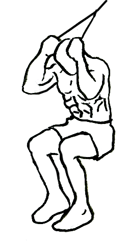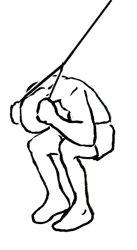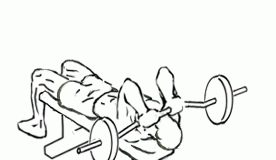Last Updated on September 26, 2014
The Seated Ab Crunch with Cable is a highly effective exercise that uses the power of a cable machine to isolate and engage your core muscles, providing the resistance needed for a deep, controlled crunch. With the correct form and technique, this workout can become an essential part of your ab routine, helping you strengthen and define your core.
Why Choose the Seated Ab Crunch with Cable?
Core training isn’t just about aesthetics—it’s essential for overall stability, posture, and injury prevention. Using a cable machine in ab exercises offers constant resistance throughout the range of motion, which can be more challenging and effective compared to bodyweight exercises. Here are some reasons why this exercise stands out:
- Variable Resistance: The cable machine allows you to adjust the weight, making it suitable for all fitness levels.
- Controlled Movement: The cable provides resistance throughout the entire movement, encouraging slow, deliberate motions for maximum muscle engagement.
- Improved Core Engagement: This exercise is an excellent way to specifically target the rectus abdominis and oblique muscles.
Muscles Targeted
The Seated Ab Crunch with Cable primarily targets:
- Rectus Abdominis: The main muscle in your “six-pack” area.
- Obliques: Muscles on the sides of your abdomen, responsible for twisting and side-bending movements.
- Transverse Abdominis: The deepest layer of abdominal muscles, crucial for stability and core strength.
Step-by-Step Guide to Performing the Seated Ab Crunch with Cable
Equipment Needed:
- Cable machine with an adjustable weight stack
- Rope attachment
- Bench or sturdy seat
Steps:
- Attach the Rope: Begin by attaching the rope handle to the high pulley of a cable machine. Adjust the weight on the stack to a level that challenges you without sacrificing form.
- Set Up the Bench: Position a bench in front of the cable machine, facing away from the weight stack. Sit with your back to the machine.
- Get into Position: Grasp each side of the rope and place it just above your shoulders, with your hands resting near your ears. Sit upright with your feet flat on the floor, shoulder-width apart.
- Perform the Crunch: Engage your core and begin to crunch by flexing at the waist, bringing your elbows toward your knees. Focus on contracting your abs rather than pulling with your arms.
- Return to Starting Position: Slowly release the crunch, returning to the starting position with control.
- Form Tips:
- Keep your hips steady throughout the movement to avoid using momentum.
- Move slowly, focusing on contracting your abs on the way down and the way up.
- Maintain a neutral spine and avoid rounding your lower back.
Common Mistakes to Avoid
To get the most out of the Seated Ab Crunch with Cable, be mindful of common errors:
- Using Your Arms: Focus on your core to bring your elbows down; avoid pulling with your arms to reduce strain on your shoulders.
- Fast Movements: Moving too quickly reduces effectiveness and can cause injury. Use a slow, controlled motion.
- Leaning Backwards: Avoid leaning backward or arching your back, as this takes the focus off your core and increases the risk of lower back injury.
Benefits of Adding the Seated Ab Crunch with Cable to Your Routine
Including cable-based crunch exercises in your workout offers several unique benefits:
- Increased Core Strength: Cable resistance requires more core engagement, contributing to overall strength.
- Greater Stability: Improving core strength helps with posture and stability in daily movements and other exercises.
- Enhanced Muscle Definition: This exercise targets multiple core muscles, helping to define and tone your midsection over time.
Incorporating Variations for Progression
To keep your routine engaging and to challenge your core, consider adding some variations:
1. Seated Ab Crunch with Twist
To engage the obliques further, add a twist to your crunch:
- Start as usual, but when you crunch, twist slightly to bring one elbow toward the opposite knee.
- Alternate sides with each rep.
2. Seated Rope Crunch with Leg Lift
Add an additional challenge for lower abs by lifting your legs as you crunch forward:
- As you crunch down, lift your feet a few inches off the floor, keeping them together.
- Lower your feet as you return to the starting position.
Ideal Rep Scheme and Weight Recommendation
For core strength, aim for 3–4 sets of 10–15 reps. If you’re new to this exercise, start with a lighter weight until you’re comfortable with the movement, then gradually increase as you build strength.
- Beginners: Start with a light weight that allows for full control. Aim for 3 sets of 10 reps.
- Intermediate: Increase to 3–4 sets of 12–15 reps, adjusting the weight as needed.
- Advanced: Use a heavier weight and aim for 4 sets of 12–15 reps, focusing on a slow, controlled descent.
How to Add the Seated Ab Crunch with Cable to Your Workout
The Seated Ab Crunch with Cable can fit into various routines, depending on your goals. Here are some options:
- Core-Specific Days: Include this exercise in a circuit with other core exercises like planks, leg raises, and Russian twists.
- Full-Body Workouts: Add it at the end of your workout to focus on core strength after completing compound movements.
- Lower Body Day: Since the core stabilizes many leg exercises, adding ab work after leg exercises is beneficial.
Sample Core Workout Routine
For a balanced core workout, consider this routine:
- Seated Ab Crunch with Cable – 4 sets of 12 reps
- Plank – 3 sets, hold for 1 minute each
- Bicycle Crunch – 3 sets of 20 reps per side
- Russian Twist with Medicine Ball – 3 sets of 15 reps per side
This routine provides a comprehensive approach to core training, targeting different areas of the abdominal muscles for well-rounded development.
Safety Tips
Ab exercises involving external resistance require attention to safety to prevent injuries:
- Warm-Up: Always warm up before engaging in core exercises to prepare your muscles and joints.
- Use Proper Form: Form is crucial for effectiveness and safety. Start with a lighter weight if you’re new to this exercise.
- Listen to Your Body: If you feel any discomfort in your lower back, modify the exercise or switch to a bodyweight version.
Benefits of Cable Training for Core Workouts
Cable training offers some unique advantages when it comes to working the core:
- Continuous Tension: Unlike traditional weightlifting exercises, cables maintain constant tension, keeping muscles engaged throughout the entire movement.
- Control Over Movement: Cables allow for smooth, controlled motions, reducing the risk of jerking or sudden movements that could lead to injury.
- Versatility: Cable machines are highly adaptable and can be used to target various muscle groups from different angles, making them ideal for core workouts.
Who Should Incorporate Seated Ab Crunch with Cable?
This exercise is suitable for a variety of fitness enthusiasts:
- Beginners: Those looking to strengthen their core without heavy weights can benefit from the adjustable resistance.
- Intermediate to Advanced Lifters: Those aiming to add more definition and challenge to their core workout can increase weight for progressive overload.
- Athletes and Active Individuals: A strong core is essential for performance in sports, and this exercise helps build a solid foundation.
Alternatives to the Seated Ab Crunch with Cable
If you’re looking to vary your core workout, here are a few alternatives:
- Kneeling Cable Crunch: Similar to the seated version but performed kneeling, allowing for a greater range of motion.
- Standing Cable Crunch: A standing version that engages core stability while isolating the abs.
- Weighted Decline Crunch: Another weighted option that also targets the lower abs.
Frequently Asked Questions
Q: How often should I do the Seated Ab Crunch with Cable?
A: For optimal results, aim for 2–3 times per week. Core muscles require rest to recover and grow, so avoid doing ab exercises every day.
Q: Should I use a heavy weight or focus on higher reps?
A: Both approaches have benefits. Heavier weights build strength, while lighter weights and higher reps enhance endurance. A balanced routine that incorporates both is ideal.
Q: Can I do this exercise if I have lower back pain?
A: If you have lower back issues, consult with a professional before adding resistance-based ab exercises. Light bodyweight exercises may be more suitable until you build up core stability.
Q: What’s the difference between the seated and kneeling cable crunch?
A: While both exercises target the core, the seated version stabilizes the hips, which can help prevent strain on the lower back. The kneeling version offers a wider range of motion.
Conclusion
The Seated Ab Crunch with Cable is an effective exercise for building core strength and definition. Its adjustable resistance makes it accessible for beginners and challenging for advanced athletes alike. By performing it with the right form and consistency, you’ll be well on your way to achieving a stronger, more defined core. Incorporate this exercise into your routine, vary the weight and reps as you progress, and experience the powerful results of cable-based core training.








